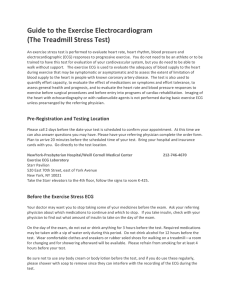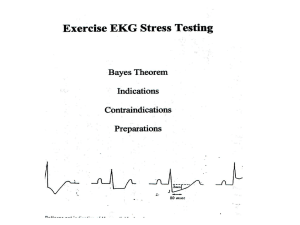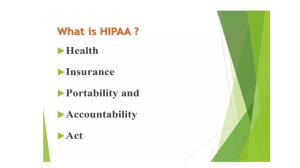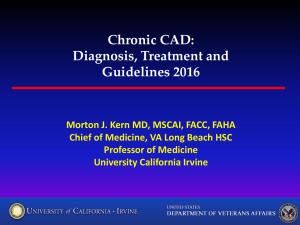Exercise Stress Testing
advertisement
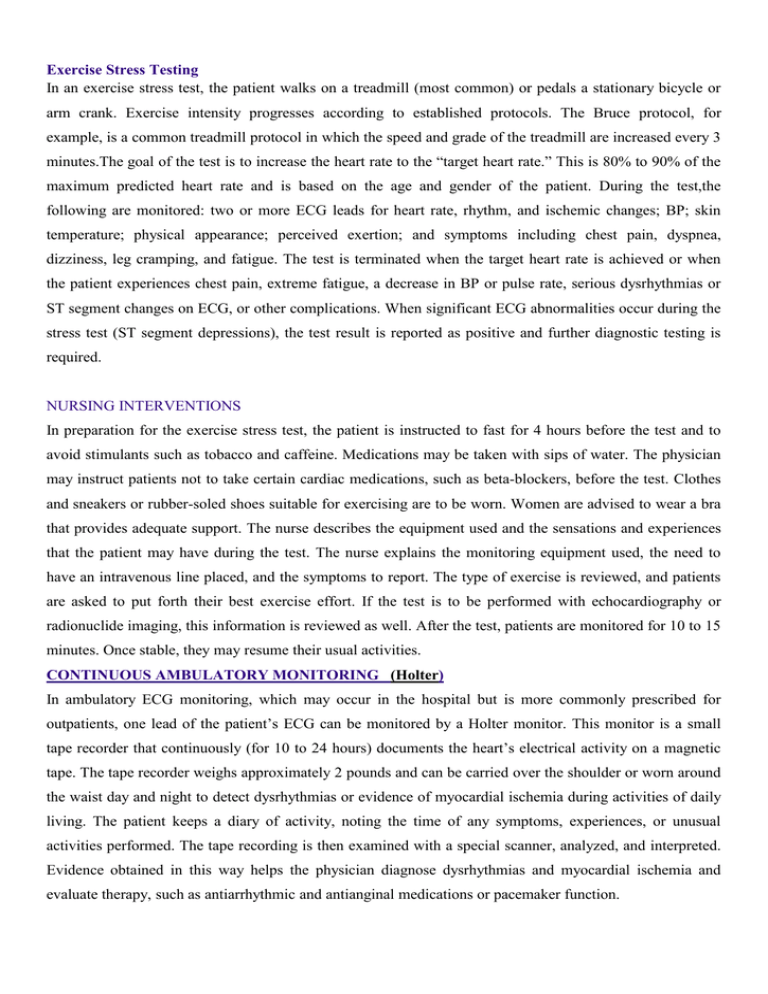
Exercise Stress Testing In an exercise stress test, the patient walks on a treadmill (most common) or pedals a stationary bicycle or arm crank. Exercise intensity progresses according to established protocols. The Bruce protocol, for example, is a common treadmill protocol in which the speed and grade of the treadmill are increased every 3 minutes.The goal of the test is to increase the heart rate to the “target heart rate.” This is 80% to 90% of the maximum predicted heart rate and is based on the age and gender of the patient. During the test,the following are monitored: two or more ECG leads for heart rate, rhythm, and ischemic changes; BP; skin temperature; physical appearance; perceived exertion; and symptoms including chest pain, dyspnea, dizziness, leg cramping, and fatigue. The test is terminated when the target heart rate is achieved or when the patient experiences chest pain, extreme fatigue, a decrease in BP or pulse rate, serious dysrhythmias or ST segment changes on ECG, or other complications. When significant ECG abnormalities occur during the stress test (ST segment depressions), the test result is reported as positive and further diagnostic testing is required. NURSING INTERVENTIONS In preparation for the exercise stress test, the patient is instructed to fast for 4 hours before the test and to avoid stimulants such as tobacco and caffeine. Medications may be taken with sips of water. The physician may instruct patients not to take certain cardiac medications, such as beta-blockers, before the test. Clothes and sneakers or rubber-soled shoes suitable for exercising are to be worn. Women are advised to wear a bra that provides adequate support. The nurse describes the equipment used and the sensations and experiences that the patient may have during the test. The nurse explains the monitoring equipment used, the need to have an intravenous line placed, and the symptoms to report. The type of exercise is reviewed, and patients are asked to put forth their best exercise effort. If the test is to be performed with echocardiography or radionuclide imaging, this information is reviewed as well. After the test, patients are monitored for 10 to 15 minutes. Once stable, they may resume their usual activities. CONTINUOUS AMBULATORY MONITORING (Holter) In ambulatory ECG monitoring, which may occur in the hospital but is more commonly prescribed for outpatients, one lead of the patient’s ECG can be monitored by a Holter monitor. This monitor is a small tape recorder that continuously (for 10 to 24 hours) documents the heart’s electrical activity on a magnetic tape. The tape recorder weighs approximately 2 pounds and can be carried over the shoulder or worn around the waist day and night to detect dysrhythmias or evidence of myocardial ischemia during activities of daily living. The patient keeps a diary of activity, noting the time of any symptoms, experiences, or unusual activities performed. The tape recording is then examined with a special scanner, analyzed, and interpreted. Evidence obtained in this way helps the physician diagnose dysrhythmias and myocardial ischemia and evaluate therapy, such as antiarrhythmic and antianginal medications or pacemaker function.


